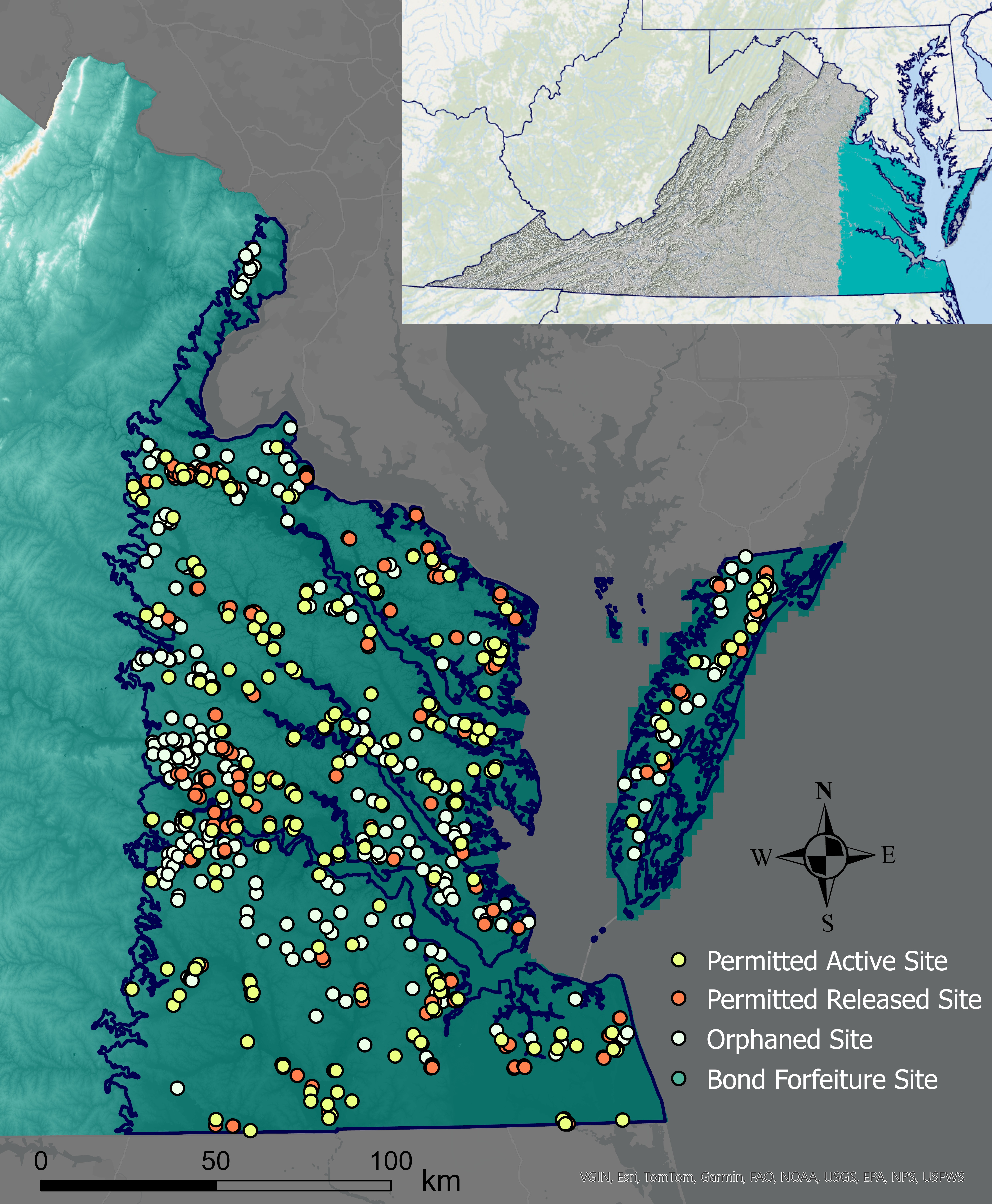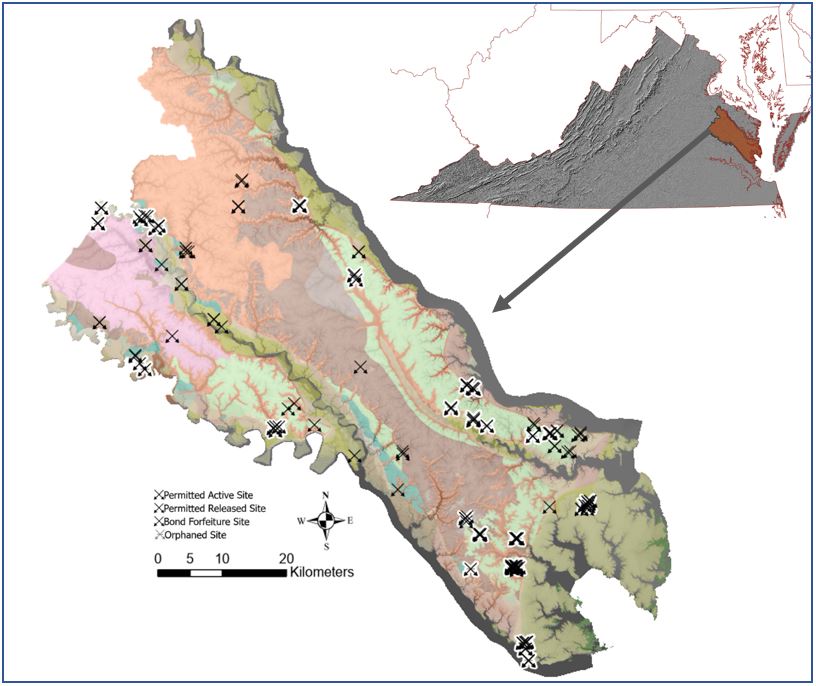Aggregate Resources
Aggregates are raw materials such as clay, sand, gravel and crushed stone that are a vital economic resource to the Commonwealth of Virginia. Virginia Energy's web site hosts an interactive story map "Aggregate in Virginia". This map identifies different types and uses of aggregate across the state. Aggregate materials are used to build structures, maintain roads, control erosion, elevate low-lying areas, and restore habitats, among other many uses (see our Mineral Resources web page for more information). Aggregate is a high-volume and low-value commodity, so transportation costs increase significantly when the material is sourced far from where it is needed. By identifying local sources, potential projects can save money and plan more efficiently and equitably for the long-term.
Why the Coastal Plain?
Aggregate-specific mapping has not yet been completed in the Virginia Coastal Plain Province. In response to this need, Virginia Energy's Geology and Mineral Resources Program recently completed an aggregate resource potential mapping project across the Middle Peninsula and is currently working in the Northern Neck region. Federal funds for this grant have been awarded by the National Oceanic and Atmospheric Administration (NOAA), and are managed by the Virginia Coastal Zone Management (CZM) Program (List of Grants).
Current coastal flood hazard models predict that a significant portion of the Rural Coastal Virginia Master Planning Region will be impacted by daily flooding by 2080 (VA Coastal Resilience Master Plan). Flooding will disrupt communities and erode land, increasing the need for a local supply of aggregate that can be used to elevate and restore infrastructure and natural systems. Planners and contractors will need to find new sources of material to meet this need.

Figure 1: Permitted and orphaned aggregate mine sites in the Coastal Plain. 10-meter Digital Elevation Model base.
Mineral resources are an important consideration for local comprehensive planning and recognized in the Code of Virginia §15.2-2224. It is mutually beneficial to municipalities, aggregate producers, prospective developers, and conservation professionals to have these aggregate data available for effective long-term planning. This project provides an opportunity to apply well-established geologic mapping and compilation methods in the Coastal Plain to localities that are threatened by significant loss of land and infrastructure due to increased flooding hazards.
CURRENT WORK
Middle Peninsula:
Virginia Energy conducted a study of potential sand, gravel, and clay aggregate resources across the Middle Peninsula. This one-year effort was funded in part by the Virginia Coastal Zone Management (CZM) Program through a grant provided by the U.S. National Oceanic and Atmospheric Administration (NOAA). The focus for this pilot phase of assessment was Virginia's Middle Peninsula, which encompasses almost 900 thousand acres, with over 1,000 miles of shoreline. Virginia Energy staff conducted a multiparameter geospatial analysis in ArcGIS including the comparison of topographic, geologic and soil maps, borehole data, occurrences of mine sites, textural data, and the presence of sensitive habitat such as wetlands. Staff also visited active mine sites across the project area for field mapping and characterization of existing aggregate materials.
The majority of potential sand and gravel deposits identified in the study are within Pleistocene fluvial-estuarine terraces, extending into older Pliocene units. Clay resources are typically limited to Miocene Chesapeake Group marine units. These data can support resilience initiatives that were identified in the 2021 Virginia Coastal Resilience Master Plan, which include efforts to mitigate widespread habitat loss, impacts to critical infrastructure, and potential residential displacement due to increased coastal flooding. Planners and contractors who are interested in materials for elevating roads, shoring up existing structures, providing shoreline protection, and restoring wetland habitats can utilize the data to understand where potential resources may occur.
This technical summary report contains a 1:100,000-scale map showing sand and gravel potential (Plate 1). A Geologic Map Schema (GeMS) Level-3 compliant geodatabase, resources, and associated metadata are included within the zip folder for download. Users should consult this report for details on methodology and criteria used for the resource potential analysis. Additional information is available within the report appendices including a field log of site visits, lithologic and geochemical data for samples, and a summary of project coordination activities throughout the grant. The final product deliverables can be downloaded from our Maps and Publications store here »

Figure 2: 1:100,000-scale sand and gravel potential map for the Middle Peninsula, included as Plate 1 in the technical summary report, finalized February 2025
Northern Neck:
To continue with efforts in the Rural Coastal Virginia region, Virginia Energy is currently working in the Northern Neck region following the same methodology as applied in the first phase (Middle Peninsula). The project is anticipated to be completed in the fall of 2025. More updates will be made available on this webpage as the project progresses.
Other Links:
Virginia Coastal Zone Management Program
Virginia CZM Program Focal Areas
Virginia CZM Program FY 2023 Grant Project List
Virginia CZM Program FY 2024 Grant Project List
Selected References:
DCR, 2021, Virginia Department of Conservation and Recreation, Virginia Coastal Resilience Master Plan, Phase One, December 2021, https://www.dcr.virginia.gov/crmp/plan.
Hawkins, D.W. and Schmidt, L.N., 2025, Aggregate resource potential reconnaissance mapping of the Middle Peninsula, Virginia: Virginia Department of Energy, Geology and Mineral Resources Program Open-file Report 2024-19, 34 p., 1 Plate, and 4 appendices.
Witt, A.C., Heller, M.J., Occhi, M.E., Spears, D.B., Lang, K.E., Berquist, C.R. Jr., and Prince, P.S., editors, 2021, Statewide Geologic Map Database of Virginia: Virginia Department of Energy, Geology and Mineral Resources Program, Open-file report 2021-12, scale 1:250,000.
